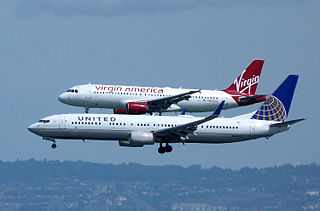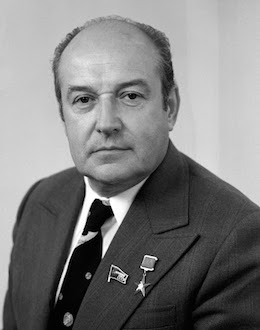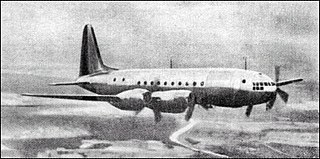Related Research Articles

The Tupolev Tu-144 is a Soviet supersonic passenger airliner designed by Tupolev in operation from 1968 to 1999.

An airliner is a type of airplane for transporting passengers and air cargo. Such aircraft are most often operated by airlines. The modern and most common variant of the airliner is a long, tube shaped, and jet powered aircraft. The largest of them are wide-body jets which are also called twin-aisle because they generally have two separate aisles running from the front to the back of the passenger cabin. These are usually used for long-haul flights between airline hubs and major cities. A smaller, more common class of airliners is the narrow-body or single-aisle. These are generally used for short to medium-distance flights with fewer passengers than their wide-body counterparts.
Pre-revolutionary Imperial Russia did not have a single national unified system but instead relied on those provided by the manufacturers of the aircraft, like Sikorsky Ilya Muromets or Anatra Anasal.

Andrei Nikolayevich Tupolev was a Russian and later Soviet aeronautical engineer known for his pioneering aircraft designs as the director of the Tupolev Design Bureau.

The Tupolev Tu-114 Rossiya is a retired large turboprop-powered long-range airliner designed by the Tupolev design bureau and built in the Soviet Union from May 1955. The aircraft was the largest and fastest passenger plane at that time and also had the longest range, at 10,900 km (6,800 mi). It has held the official title of fastest propeller-driven aircraft since 1960.

Aleksey Andreevich Tupolev was a Soviet and later Russian aircraft designer who led the development of the first supersonic passenger jet, the Tupolev Tu-144. He also helped design the Buran space shuttle and the long-range heavy bomber Tu-2000, both of which were suspended for lack of funding.

The Tupolev Tu-110 was a jet airliner designed and built in the USSR, which saw its maiden flight in 1957.
The Tupolev Tu-70 was a Soviet passenger variant of the Tu-4 bomber, an unlicensed, reverse engineered copy of the Boeing B-29 Superfortress. Designed immediately after the end of World War II, it used a number of components from Boeing B-29s that had made emergency landings in the Soviet Union after bombing Japan. It had the first pressurized fuselage in the Soviet Union and first flew on 27 November 1946. The aircraft was successfully tested, recommended for serial production, but ultimately not produced because of more pressing military orders and because Aeroflot had no requirement for such an aircraft. A military cargo aircraft version was the Tupolev Tu-75.

The JSCSukhoi Company is a Russian aircraft manufacturer, headquartered in Begovoy District, Northern Administrative Okrug, Moscow, that designs both civilian and military aircraft. It was founded in the Soviet Union by Pavel Sukhoi in 1939 as the Sukhoi Design Bureau. During February 2006, the Russian government merged Sukhoi with Mikoyan, Ilyushin, Irkut, Tupolev, and Yakovlev as a new company named United Aircraft Corporation.

Tupolev, officially United Aircraft Company Tupolev - Public Joint Stock Company, is a Russian aerospace and defence company headquartered in Basmanny District, Moscow.

The Tupolev Tu-334 was a Russian short-to-medium range airliner project that was developed to replace the aging Tu-134s and Yak-42s in service around the world. The airframe was based on a shortened Tu-204 fuselage and a scaled-down version of that aircraft's wing. Unlike the Tu-204, however, the Tu-334 has a T-tail and engines mounted on the sides of the rear fuselage instead of under the wings. With the nationalisation of the Russian aircraft companies in 2009 to form United Aircraft Corporation it was decided not to continue with the programme.

The Tupolev ANT-14 Pravda was a Soviet aircraft, which served as the flagship of the Soviet propaganda squadron. It has been credited as Russia's first all-metal aircraft, with a corrosion-resistant-steel structure.
The Tupolev ANT-9 was a Soviet passenger aircraft of the 1930s. It was developed as a reaction to the demand for a domestic airliner. At this time Deruluft, one of the forerunners of Aeroflot, flew only with foreign models, which were mainly German or Dutch.

The ANT-2 was the first all-metal aircraft designed by the Tupolev design bureau. A small passenger plane, it could carry two passengers in a cabin behind the pilot.
The Tupolev TB-6 was a proposal by the Tupolev Design Bureau in the 1930s for a super-heavy bomber. Had it been built, it would have been the biggest-ever Soviet bomber and the largest aircraft by wingspan of its time, nine feet short of the 320 foot span of the Hughes H-4 Hercules, although the Scaled Composites Stratolaunch is now the biggest plane by wingspan.

The Tupolev ANT-35 was a 1930s Soviet twin-engined light transport monoplane that entered service with Aeroflot in 1937 as the Tupolev PS-35.

The Ilyushin Il-18 was a Soviet four-engined airliner designed and built by Ilyushin immediately after World War II. Although the aircraft itself was successful, its Shvetsov ASh-73TK engines were too unreliable for civilian use and were further needed to equip the Tupolev Tu-4 bomber, so it was cancelled in 1948.

The Tupolev Tu-116 is a turboprop-powered long-range airliner designed by the Tupolev design bureau and built in the USSR.
The Tupolev ANT-43 was an experimental passenger aircraft designed and built by the Tupolev Design Bureau in the 1930s, for purposes of gaining practical experience with the so-called "placemeter" production method.
References
- ↑ Gordon, Yefim; Rigamant, Vladimir (2005). OKB Tupolev: A History of the Design Bureau and its Aircraft. Hinckley, England: Midland Publishing. ISBN 1-85780-214-4.
- ↑ Gunston, Bill (1995). Tupolev Aircraft since 1922. Annapolis, MD: Naval Institute Press. ISBN 1-55750-882-8.